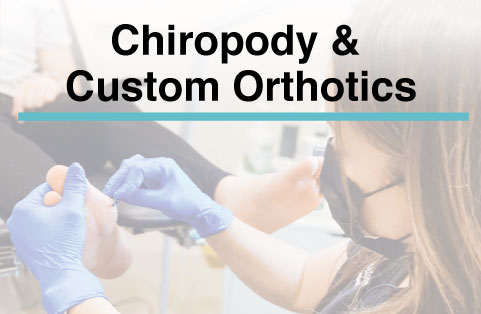
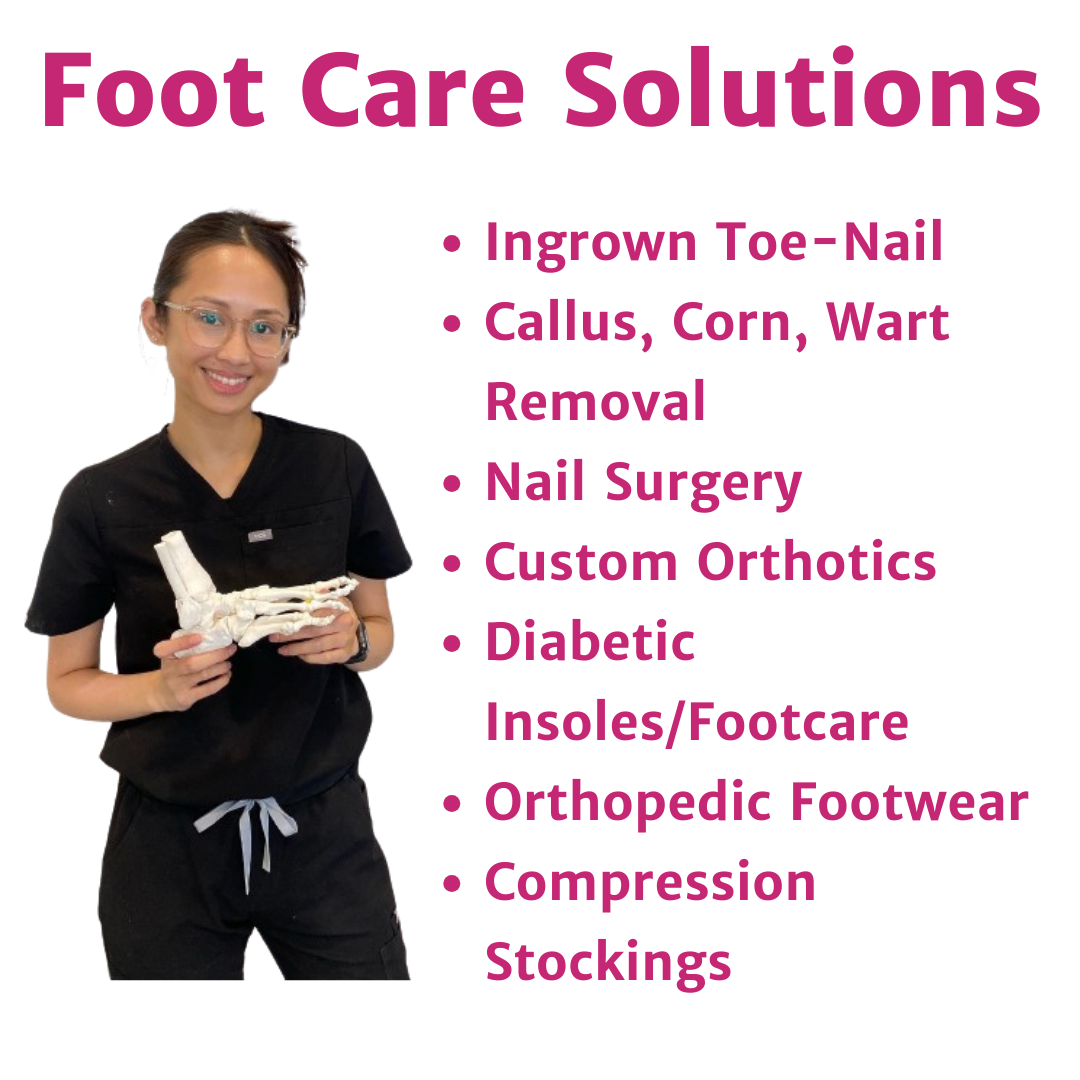
Reserve Your Appointment Today
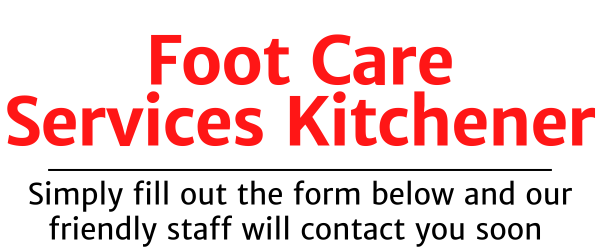
WILSON HEALTH SERVICES IS LOCATED AT THE SOUTH END OF KITCHENER
Kitchener Chiropody & Foot Care Clinic
The goal of our Kitchener Chiropodist at Wilson Health Services is to enhance the quality of life for all of our patients. They do this by preserving and enhancing patient mobility, treating foot discomfort, and educating patients about their health. Chiropody is a medical specialty that focuses on the assessment, management, prevention, and treatment of foot and lower limb disorders, including a broad range of ailments, traumas, and local symptoms of clinical conditions.
A Chiropodist is a primary care practitioner who specializes in the assessment, management, treatment, and prevention of foot ailments and disorders.
Reserve Your Appointment Today

CHIROPODY | FOOT CARE | INGROWN TOENAILS | ORTHOTICS KITCHENER
Contact Your Local Foot Care Specialist
● Foot Care ● Callus, Corn, Wart Removal ● Ingrown Toenails ● Nail Surgery ● Custom Orthotics ● Compression Stockings
The role of our Kitchener Chiropodist at Wilson Health Services is to improve all patients’ quality of life. They do this by maintaining and improving patient mobility, alleviating foot pain, and providing health education. Chiropody is a branch of medical science that involves the assessment and management of foot and lower limb disorders: this includes the management of a wide variety of disorders, injuries, and local manifestations of systemic conditions.
A Chiropodist is a primary care health practitioner that specializes in the assessment, management, and prevention of diseases and disorders of the foot.
GET ON THE PATH TO RECOVERY, BOOK YOUR APPOINTMENT TODAY!
How Can A Chiropodist Help You &
What Is Chiropody?
Chiropody (pronounced chi-rop-o-dy) is the assessment, treatment, and prevention of foot and lower limb disorders using therapeutic, surgical, orthotic or palliative means.
Chiropody is the health care profession that specializes in the assessment and treatment of foot conditions. Physicians as well as other health care professionals often refer their patients to a Chiropodist for consultation. A referral to our Chiropody or Podiatry clinic from a physician is not required.
The Wilson Health Services Chiropodist is an important member of the health care team.
Chiropody training involves extensive theoretical, practical and clinical aspects of normal and pathological mechanics of the lower limb. Our Kitchener Chiropodists are trained in the casting and “dressing” of orthoses and subsequent fabrication of functional and accommodative orthotic devices. Lower limb biomechanics is the domain of Chiropody, which originated the concept of orthoses and continues to lead the way in improving foot function through orthoses.
Chiropodists are primary care providers qualified to assess, prescribe and carry out treatments including minor surgical procedures, therapeutic treatments including: laser, ultrasound, iontophoresis, extracorporeal shock wave therapy, and electrical treatments.
We also offer custom foot orthotics and at our other locations.
At Wilson Health Services Foot Care & Orthotics, our Kitchener Chiropodists believe that foot health plays an important role in overall health. We strive to provide you with the best foot care possible to return you to your optimal self with excellent service, quality products and expertise.
Many diseases and ailments manifest themselves first in the foot therefore taking care of these precious gems is of the utmost importance.
Wilson Health Services Advantages




Foot Care Services Include
- Nail Care
- Diabetic Foot Care
- High Risk Foot Care
- Callus Removal
- Wound Management
- Customized / Modified Orthopedic Footwear
- Gait Analysis
- Foot Care
- Corn Removal
- Wart Treatment
- Custom Foot Orthotics
- Diabetic Insoles
- Sports Injuries Management
- Biomechanical Assessment
- Pediatric Foot Management
- Nail Surgery
At Wilson Health Services Foot Care & Orthotics we focus on using therapeutic, surgical, orthotic or palliative means to bring you back to your normal self through exceptional care.
GET ON THE PATH TO RECOVERY, BOOK YOUR APPOINTMENT TODAY!
Meet our chiropodists of Wilson Health Services
Patricia Wilson | Lead Chiropodist at Wilson Health

Patricia Wilson (BScN, RN, DCh), fondly known as Patricia, is our proudly Canadian Guelph Chiropodist at Wilson Health. Patricia’s journey to a career that she loves is a beautiful story and her positivity is infused with a spirit of gratitude and humility.
With deep roots back in Colombia where she lived for much of her teenage years and early adulthood, she returned to Canada as a young adult to pursue a nursing career. Her rewarding twelve years as a pediatric nurse instilled her strong commitment and deep values to help others. This love for patients as their health advocate would lead her to the healing profession of Chiropodist and custom orthotics care.
Patricia understands the medical science behind injuries and issues surrounding the feet and how that can affect the entire body. Understanding that many diseases and ailments can show up first in the foot, Patricia believes she has a purpose-driven career that brings meaning, prevention, education and exceptional care to the people she serves.
With her personalized approach, backed by a wealth of experience and dedication to her patients, Patricia has gained a notable reputation in the field of chiropody care throughout the Waterloo Region and Guelph area.
Blending a caring, inclusive environment with access to education and various therapy options to encompass health challenges reflects her approach to healthy living and overall wellness. Patricia embraces the opportunity to educate her patients from simple things about how to cut their toenails to warning signs and complexities of the biomechanics of the feet and lower extremities.
Patricia’s love for people and her endearing smile put people at ease from the very first consultation. Her interest in every patient goes far beyond foot conditions and care, as she makes every effort to support and guide her clientele to help with the issues they face.
With her husband Dr. Jay Wilson, they have created a family wellness centre in Cambridge that works hard to improve their patients’ quality of life. In 2018, Patricia opened the Guelph clinic to expand the services to that demographic. Improving mobility, providing education and alleviating pain are fundamental values they both share.
Patricia’s commitment and love for people starts at home. She adores her husband Jay, their three beautiful children, their dog Bernie and the life they have created together in the Puslinch Lake community. As Patricia always says, she loves them all to the moon and back, forever and ever, and to infinity and beyond.
Patricia manages all her roles seamlessly and loves making a difference that changes lives for the better, one foot at a time.
Lorraine Baclit | Wilson Health Chiropodist
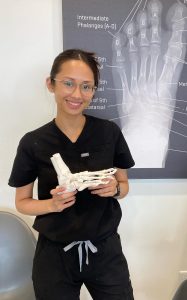
Lorraine studied at the University of Toronto and completed her education at the Michener Institute. She trained at the Michener Chiropody Clinic and right here at the heart of Wilson Health Services, integrating herself into the team quickly. Having grown her skills and rapport on-site, she is a familiar face and well-acquainted with everybody alike.
Her compassion and ability to connect with anyone creates a positive experience for all. Her manner is gentle, sincere, and enthusiastic. Lorraine is passionate about sharing her knowledge of foot health and providing a comprehensive treatment approach to improve the quality of life for all her patients. She looks forward to becoming your foot specialist!
In her time off, Lorraine enjoys spending time with friends and family, reading, and binge watching her favourite TV shows.
Nicole Yee | Chiropodist Wilson Health Kitchener
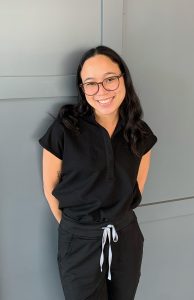
Nicole Yee received her Honours Bachelor of Science from McMaster University in Life Sciences in 2019 before going on to complete the Michener Institute’s Diploma of Chiropody in 2022.
Nicole grew up in Mississauga but now resides in Kitchener, Ontario. Her passion for improving foot health traces back to her background running track & field and cross country. She had consulted foot specialists herself for sports injuries over the years and became interested in the full scope of practice Chiropody offers.
Nicole is passionate about providing complete and compassionate foot care with a holistic approach. She prioritizes listening to her patient’s concerns and connecting to them.
When she isn’t helping out a patient with their foot health, Nicole enjoys working out, trying out new recipes, and having paint nights with friends. She looks forward to helping you take a “step” towards pain-free, healthy feet!
Carissa Collins | Chiropodist Wilson Health Kitchener
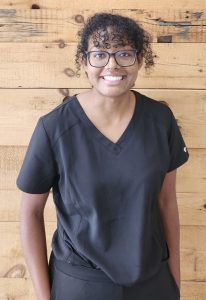
Carissa Collins majored in Bio-medical science at the University of Guelph, Carissa’s academic journey laid the foundation for her career in foot care.
After completing her education, Carissa’s path led her to the Chiropody Program at the Michener Institute, where she started honing her clinical skills and discovered her innate love for patient care. Her time at Michener emphasized the significance of collaboration, inspiring her to work harmoniously with her peers to ensure the best possible outcomes for her patients.
Now, Carissa is excited to rejoin the Tri-Cities community, a place close to her heart, and extend her expertise to the people within and around it. Her commitment to improving the well-being of her patients shines through in her dedication and genuine care.
Outside of the clinic, Carissa enjoys spending quality time with her loved ones baking, and embarking on outdoor adventures through hiking trails.
Chiropodist vs Podiatrist
Chiropody is a healing profession dedicated to feet. Podiatrists and chiropodists are both members of the chiropody field, and in Ontario, Canada they are regulated by the same governing body. But what differences separate the chiropodist and the podiatrist?
A Podiatrist is a Doctor of Podiatric Medicine, these are practioners that were educated in the United States. They possess a four-year doctoral training program at a college of podiatric medicine followed by at least three years of podiatric medical and surgical residency. In Ontario, as of July 1993 a cap was placed and no other Podiatrist were registered at The College of Chiropodist of Ontario. All Podiatrist coming from the United States were registered as Chiropodist as well.
Podiatrist are permitted to bill OHIP and communicate a “diagnosis” where Chiropodist are not allowed to do either. Podiatrist are able to complete bone surgery where Chiropodist are limited to soft tissues such as tendons.
At Wilson Health Services , we offer both Chiropody services. Call us today at (519) 836-8008 to learn which service is right for you.
GET ON THE PATH TO RECOVERY, BOOK YOUR APPOINTMENT TODAY!
Custom Foot Orthotics in Kitchener
Orthotics For Foot Issues
Whether you are struggling with back, leg, foot or heel pain, one of the many causes could be the shoes you are wearing. It is essential to wear the right shoes as the weight of your entire body rests on your feet. When your feet are not comfortable and at ease due to ill fitting shoes, your life can be miserable.
If you have heard of custom made foot orthotics, your problem can be easily solved. Whether you have a flat foot, pain due to diabetes or other ailments, these little shoe inserts can be one of the many solutions out there. Even athletes opt for custom foot orthotics to help them get relief from pain as well as offer comfort.
What to know about foot orthotics
Orthotics are devices that can be inserted into most shoes by our Chiropodist. Orthotics help in providing alignment and support to the foot, improve foot function and accommodate and correct foot abnormalities. If used with the proper footwear they are highly effective in treating various types of foot and lower leg issues.
Why do I need orthotics?
Our Chiropodists and Podiatrists have been advising and prescribing orthotics for many years. The primary reason behind its application is that it balances and stabilizes the feet and lower limbs. When there is a solid support foundation for your feet, you can be comfortable while walking or even running. All your foot associated pain, posture issues, muscle tiredness can recover faster.
Orthotics can help you primary with:
- Foot pain
- Heel Pain
- Achilles pain
- Knee pain
- Shin aches
- Lower back pain
- Neuropathic pain
- Callus or corns
If you are facing problems in any of the above mentioned areas, please contact your local Kitchener chiropodist and find out whether you need orthotics or not.
GET ON THE PATH TO RECOVERY, BOOK YOUR APPOINTMENT TODAY!
Who Can Benefit From Orthotics?
People suffering from an ongoing foot pain
If you have continuous foot pain, it can be very difficult to lead a normal daily life. If you are not able to stand and walk properly and feel you need support. In such situations, custom made orthotics can be really helpful.
A diabetic patient
Diabetes can trigger nerve damage in the feet, and it is often the first place neuropathy manifests itself. As such diabetic patients lose sensation and therefore fail to feel cold or hot conditions, as well as pain and stress in their feet that may cause callus and corns that can lead to pressure ulcers if left untreated. There are many individuals suffering from diabetes who use orthotics in order to reduce or eliminate foot problems.
Our Chiropodist can help!
A patient with arthritis
Arthritis is a very painful condition that can damage the joints of certain parts of your body. Painful conditions in your legs, knee, and feet can occur. Chiropodists have found that orthotics are very beneficial.
Runners and athletes
Individuals, who are active in sports benefit from custom made foot orthotics, increasing their strength, endurance and the ability to perform better. Orthotics provide support and alignment to the muscles, bones, tendons and ligaments of your leg to work efficiently and also prevent injuries and pain.
Back and knee pain sufferers
If you have a persisting pain in your knees, hips, and lower back region and didn’t receive any comfort with the conventional treatment, there could be some issue with your foot biomechanics. Our Chiropodist may suggest orthotics as an excellent way to give you relief from your symptoms.
How do orthotics work?
In order to understand the function of orthotics, it is essential to understand the walking mechanism. With every step you give, your heel’s vertical axis must land inverted slightly to the ground with a position of a few degrees towards the heel’s outside. It is from where when your foot will start to flatten and come off the ground at the toes.
Henceforth, when you step, the weight actually swifts from outside of your foot to the inside of your foot and then again back to the lateral. The problem lies when these motions are too pronounced in the case of plantar fasciitis or not happening as much in the case of a pes cavus. When you seek the support of a corrective orthotic, it can impede your arch from dropping too much or it will aide your feet to absorb the shock and eliminate stress and pain.
Types of Orthotics
When you consult our Chiropodist, she will prescribe you with either of the two categories.
Functional orthotics
It is basically designed for those with abnormal foot functioning. Such devices are made of plastic polymer materials, which is effective in preventing the flattening of the arch. While you walk or run, functional orthotics are also able to absorb the shock from the ground and reduce stress and rule out possibilities of any injury.
Accommodative orthotics
If you suffer from minor foot issues and foot pain, accommodative orthotics are best considered. This foot device is often prescribed to older adults that require a device to accommodate previous malformities like bunions, hammer toes, etc.
GET ON THE PATH TO RECOVERY, BOOK YOUR APPOINTMENT TODAY!
Foot Conditions
Warts
Plantar warts are growths that usually appear on the heels or balls of your feet and most resolve on their own and do not pose a serious health concern. However, on occasion plantar warts can cause pain and discomfort and may need to be removed with special medication. The most common symptoms of a plantars wart are a small, fleshy, rough, grainy growth on the bottom of your foot that may or may not be accompanied by black pinpoints. Many people confuse a wart with a corn but one of the characteristics of a wart is that interrupts the normal lines and ridges in the skin of your foot where a corn does not.
Plantar warts are caused by an infection with the human papillomavirus (HPV) in the outer layer of skin on the soles of your feet. The most common places for HPV to thrive is warm and moist environments like a locker room or swimming pool.
Most plantar warts go away without treatment, though it may take a year or two. If your warts are painful or spreading, please contact us today.
Toe Types
Hammer toe, Mallet Toe, and Claw Toe are all different types of conditions that can result in serious discomfort.
Hammer Toe
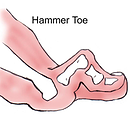
Mallet Toe
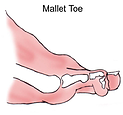
A mallet toe occurs when the joint at the end of the toe cannot straighten. Mallet toes can cause extreme discomfort, and can be aggravated if restrictive or improperly fitting footwear is worn for a prolonged period of time.
Claw Toe
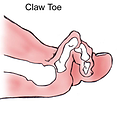
To Learn more, call our Chiropodist today!
Tenia Pedis
Athlete’s foot is a common fungal infection of the skin on the feet. Fungal germs or fungi often occur in small numbers on human skin where they usually do no harm.However, if conditions are right they can invade the skin, multiply, and cause infection. The conditions fungi like best are warm, moist and airless areas of skin, such as between the toes.
Athlete’s foot can also be passed on from person to person and common symptoms include:
- A rash that becomes itchy and scaly.
- The skin may become cracked and sore.
- Tiny flakes of infected skin may fall off.
- The rash may spread gradually along the toes if left untreated.
- In some cases it spreads to the soles.
- Scaling rash on the entire sole and side of the foot
Fungi do not usually go deeper than the skin into the body. However, other germs (bacteria) may enter through the cracked skin of untreated athlete’s foot. This can occasionally cause more serious infections of the foot or leg.The infection sometimes spreads to a nail. This can be treated.
Shin Splints
Shin splints are a common complaint, especially among runners and other athletes. Patients experience pain in the front or inside aspect of the lower leg or shin due to overexertion of the muscles after running or even walking. The pain usually comes gradually without a history of trauma. Shin splints should not be left untreated because there is an increased risk of stress fractures.
Shin splints can be caused stress to the muscles in the front of the foot. Common causes are wearing athletic shoes that are worn out and don’t have enough shock absorption, flat feet that lead to increased stress on the lower leg muscles during exercise, high arched feet that have poor shock absorption.
Posterior Tibial Tendonitis
The posterior tibial tendon runs along the inside of the ankle and the foot. The posterior tibial tendon runs behind the inside bump on the ankle, across the instep, and into the bottom of the foot. The tendon is important in supporting the arch of the foot and helps turn the foot inward during walking. When there is post-tibial tendon disfunction, the tendon does not function to hold up the arch, resulting in flat feet. This can lead to heel pain, arch pain, plantar fasciitis and/or heel spurs. Pain will be more severe upon weight bearing, especially while walking or running.
Posterior tibial tendonitis occurs when the muscle is overused and the tendon that connects the muscle to your bone is strained. Years of flat feet can also lead to posterior tibial tendon dysfunction. If you keep overusing the muscle, damage to the tendon builds up and tendonitis develops. At first the pain or swelling may come and go quickly, but eventually the problem may become more permanent.
Ingrown Nails
Ingrown toenails are a very common problem affecting primarily the great toenail. An ingrown nail curves down and into the surrounding skin as it grows, causing the skin to grow over the nail. Symptoms of ingrown toenails are sore, often painful, nail folds with various degrees of redness, swelling, and sometimes clear or yellow drainage. Frequently, ingrown toenails resolve without medical treatment. Complicated cases may require treatment by a foot care specialist.
Ingrown toe nails care caused by the sideways growing portion of nail acting like a foreign body and pokes into or pinches off a small piece of skin at the outer edge of the toe. This may cause a break in the skin, causing inflammation and possibly infection. The inflammation often causes more thickening of the nail skin fold, further exacerbating the problem. The protruding piece of nail keeps pushing into the skin, causing further injury and pain.
Heel Pain
Heel pain is a common condition where putting weight on the heel causes extreme discomfort. On occasions, heel pain can be caused by over-use repetitive stress from too much impact on a specific area of the foot. Heel pain syndrome can have many causes. Wearing shoes with heels that are too low, a fat pad in the heel area that has thinned, or from a sudden increase in activity are just a few of the possible causes. Another possible cause of heel pain is plantar fasciitis.
Fungal Nails
Fungal nail infections are common. The infection causes thickened and unsightly nails which sometimes become painful. Toenails are more commonly affected than fingernails. It is more common in people aged over 55, and in younger people who share communal showers.Fungal nails can spread from a fungal skin infection. like athlete’s foot. A nail that has recently been damaged is also more likely to become infected. You have an increased risk of developing a fungal nail infection if you have various other conditions like diabetes, psoriasis, poor circulation, a poor immune system or a general poor state of health.
Often the infection is just in one nail, but several may be affected. At first the infection is usually painless. The nail may look thickened and discoloured but there are no other symptoms. White or yellow patches may appear. The nail may become soft and crumble. Bits of nail may fall off. The skin next to the nail may be inflamed or scaly. If left untreated, the infection may eventually destroy the nail and the nail-bed, and may become painful.
Fungal nails are difficult to treat and treatment does not always cure the infection and even if it does, it may not restore the nail’s appearance to normal. The anti-fungal medicines used need to be taken for several months – sometimes longer.
Corns and Callus
Corns and Calluses are two very similar and extremely common foot conditions.
Corns
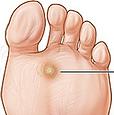
Corns can be caused by wearing tight fitting footwear, high heeled footwear, tight fitting stockings and socks, deformed toes, or the foot sliding forward in a shoe that fits too loosely. Corns in between the toes can result from bony prominences.
Callus
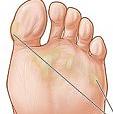
Calluses develop because of excessive pressure at a specific area of the foot. High-heeled dress shoes, shoes that are too small, obesity, abnormalities the way you walk, flat feet, high arched feet, bony prominences, and the loss of the fat pad on the bottom of the foot are all common causes of calluses.
Bunions
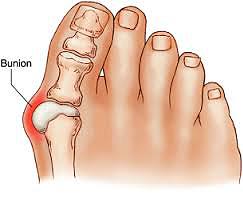
Symptoms of bunions include inflammation, swelling, and soreness on the side surface of the big toe. The discomfort commonly causes a patient to walk improperly.
Some people develop bunions from wearing shoes that do not fit correctly (especially high heels or narrow-toed shoes). For other people, bunions are caused by factors beyond their control. These can include a family history of a foot type that is susceptible to bunions, neuromuscular disorders, conditions affecting the joints (e.g., arthritis), severe injury to the foot, deformities at birth and problems that affect the way a person walks (e.g., rolling in at the ankles, pronation, etc.)
Achilles Tendonitis
Achilles tendonitis causes inflammation and degeneration of the achilles tendon. The achilles tendon is the large tendon located in the back of the leg that inserts into the heel. Pain can develop gradually without a history of trauma. Achilles tendonitis should should always be treated as there is a possibility that the tendon can become weak and ruptured. Achilles Tendonitis can be caused by excessive stress to the tendon by sports or running, as wel as prolonged periods of standing.
Symptoms of achilles tendonitis often begin as a mild ache in the back of the leg or above the heel after running or other sports activity. Episodes of more severe pain may occur after prolonged running, stair climbing or sprinting. Individuals who suffer from achilles tendonitis often complain that their first steps out of bed in the morning are extremely painful. Another common complaint is pain after steps are taken after long periods of sitting. This pain often lessens with activity.
The most common cause of achilles tendonitis is over-pronation. Over-pronation occurs when the arch collapses upon weight bearing, adding stress on the achilles tendon. Other factors that lead to achilles tendonitis are improper shoe selection, inadequate stretching before sports, a short achilles tendon, direct trauma to the tendon, and heel bone deformity.
Plantar Fasciitis
Plantar fasciitis is a common painful foot condition of the heel and soles of the foot. It is characterized by inflammation or deterioration of the plantar fascia of the foot. The plantar fascia is a thick fibrous band of connective tissue that originates from the your heel bone, extends along the sole of the foot and inserts at the base of the toes The plantar fascia supports the arch of the foot.
The most common cause of plantar are overuse of the plantar fascia, increase in physical activity, or weight gain. It is commonly associated with long periods of weight bearing and is much more prevalent in individuals with flat feet or fallen arches.
Plantar fasciitis pain is usually felt on the underside of the heel and is often most intense with the first steps of the day. Those with plantar fasciitis often have difficulty bringing their toes toward the shin and is usually due to tightness of the gastrocnemius muscle or Achilles tendon.
Plantar Fasciitis
Plantar fasciitis is a common painful foot condition of the heel and soles of the foot. It is characterized by inflammation or deterioration of the plantar fascia of the foot. The plantar fascia is a thick fibrous band of connective tissue that originates from the your heel bone, extends along the sole of the foot and inserts at the base of the toes The plantar fascia supports the arch of the foot.
The most common cause of plantar are overuse of the plantar fascia, increase in physical activity, or weight gain. It is commonly associated with long periods of weight bearing and is much more prevalent in individuals with flat feet or fallen arches.
Plantar fasciitis pain is usually felt on the underside of the heel and is often most intense with the first steps of the day. Those with plantar fasciitis often have difficulty bringing their toes toward the shin and is usually due to tightness of the gastrocnemius muscle or Achilles tendon.
CONTACT WILSON HEALTH SERVICES KITCHENER LOCATION
About Wilson Health Services
Wilson Health Services was founded in June of 2001 by Dr. Jason Wilson, he has expanded Wilson Health Services into four multidisciplinary clinics serving Cambridge, Guelph, Kitchener and Paris. Our team includes Chiropractors, Registered Massage Therapists, Physiotherapists, Naturopaths, Chiropodists, Osteopath.
OUR MISSION
Our mission is to empower our patients and community to expand their level of health and vitality. We will inspire our family of patients to embrace true health from the inside out and to embody wellness which is far superior to the treatment of disease.
WHY CHOOSE US?
It’s simple. We recognize that each discipline of healthcare is as unique as each individual patient. Whatever therapy or therapies you choose, in turn, deserve their complete and undivided attention. At Wilson Health Services each practitioner is specialized and has individual training for the treatment they provide. By choosing our multidisciplinary approach to health, you can achieve a faster and more efficient outcome, as you receive a complete and thorough treatment with each therapy.
Our clinic has a warm, welcoming, friendly, and positive environment to fulfill all of your natural healthcare needs.


